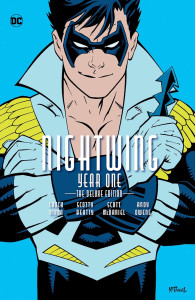 The words “Year One” when applied to the title of a DC Comics series carry with them tremendous responsibility. Batman: Year One was a seminal event in superhero comics, and a worthy bookend to The Dark Knight Returns. Robin: Year One is an understated and moving relationship piece that skillfully lays out the fracture lines in any relationship Batman tries to establish. And so it goes, setting a very high bar for Nightwing: Year One to attempt to reach.
The words “Year One” when applied to the title of a DC Comics series carry with them tremendous responsibility. Batman: Year One was a seminal event in superhero comics, and a worthy bookend to The Dark Knight Returns. Robin: Year One is an understated and moving relationship piece that skillfully lays out the fracture lines in any relationship Batman tries to establish. And so it goes, setting a very high bar for Nightwing: Year One to attempt to reach.
Sadly, the attempt isn’t particularly successful. In large part, this is because the story lacks emotional heft. One of the real pleasures of the Year One books is the way in which they generally do a good job of tracing the underlying emotional terrain of stories the reader already knows well. With Robin: Year One, for example, everyone who picks the book up is likely to know about the death of Dick Grayson’s family on the trapeze, his subsequent adoption by Bruce Wayne and so forth. As a result, the plot isn’t why we read a story like that. Rather, they’re exercises in character illumination, a chance for the writer to ease back on the plot throttle and instead do some exploration of the whys and wherefores that would drive a man like Bruce Wayne to adopt an orphan, take a partner, and expose a child to the sorts of dangers that lurk on Gotham’s rooftops.
That, ultimately, is where Nightwing: Year One goes wrong. There’s too much story and not enough character, and the end result feels like a forced rush to a known endpoint. What could have been life- and psyche-changing events, starting with Grayson’s being fired by Batman, are submerged in the hurry to show off Nightwing, all grown up and independent.
It’s the firing that gets the ball rolling in this case, as a couple of blunders during a tussle with Clayface get Batman’s dander up, to the point where young Master Dick is given his walking papers. While the introduction makes notice of the logistical difficulties inherent in Grayson’s situation at this point, the book itself doesn’t, which means that Batman comes across as a one-dimensional meanie whom no one would actually want to partner with. On his own, Grayson gets some career advice from Superman and tries to go back to his circus roots before inevitably drifting back into Batman’s orbit. The former sequence is a success, largely because it plays up the fact that Superman is not in fact human, and can thus provide some fairly unique perspective on Grayson’s problems. The latter, on the other hand, doesn’t work nearly as well. This may be due to an extended appearance by the relentlessly meta Deadman. Conversely it may just be because there’s never any real attraction to the circus presented and no real indication that Grayson’s even vaguely likely to stay. As such the reader knows that Grayson is just marking time before coming home.
Once Grayson gets back to Gotham, the pace picks up, possibly even a little too much. The plan to establish Nightwing as a crimefighter with a rep is amusing enough, but it plays like a montage, and when things inevitably go wrong at the hands of Killer Croc, it feels more like coincidence than a real test of Grayson’s new identity and sense of self.
Throughout all of this, Batman remains largely a non-presence, a rude autocrat of the kingdom of the Batcave whose decision to take on new Robin Jason Todd seems capricious at best. Long-suffering butler Alfred comes across much better, and if there is an emotional core to the book, it comes from the butler’s relationship with and paternal love for Dick Grayson. Sadly, this affection extends to haberdashery, and the original Nightwing costume (complete with disco collar) is revealed as Alfred’s work.
The best thing that can be said for Nightwing: Year One is that it fills in a gap. What it doesn’t do, though, is really get into the meat of what might happen to someone whom the Batman threw out. The end is never in doubt, and the journey to get there feels like it’s by means of the shortest route possible. For all of the book’s good elements, from Scott McDaniel’s sharp, iconic pencils to the lovely throwaway reference to the original Batman film, the story is what ultimately lets Nightwing: Year One down, and it does so by taking center stage. The book feels like it should have been a story about who Nightwing was, not about what he did. Unfortunately, the difference is crucial.
(DC Comics, 2005)
